Where’s your fish from in Jersey?
27.05.22 Back
Surrounded by sea, you’d be forgiven for assuming that most of the fish we eat in Jersey comes from our own waters… but actually, the island imports the vast majority of the fish we eat. Why can’t we source more of our seafood locally?
Dive into seafood sourcing with us, as we discuss where Jersey’s seafood comes from, and what happens to the fish and shellfish that’s caught here.
And don’t miss our complete fish-by-fish guide, for details of each fish and shellfish that you’ll find on Jersey restaurant menus.

JPRestaurants started to focus on the challenges of sourcing local fish more than ten years ago, to counter the reliance of local restaurants on the tide of imported fish. We worked hard at finding solutions but we, like the rest of Jersey, have not succeeded.
Take a glance at most local menus today and you’ll see many seafood dishes containing the “big four”: cod, tuna, salmon and prawns. None of these will have been sourced from our local waters.
Apart from our wonderful local lobster, crabs, and oysters, most “wet fish” (as opposed to shellfish) you see on local restaurant and pub menus will not have been caught locally even if it could, unlike the big four, have been targeted and caught by our local commercial fishing fleet.
Jersey is an island surrounded by some of the most productive and nutrient rich waters in the world, but the uncomfortable truth is that the island imports over 90% of the wet fish we eat. The island even exports 60% of the live crab that Jersey fishermen land locally (even more is landed by them in France). And yet we have to import picked crab from the UK to satisfy demand, especially in the summer.
The reasons for this sad state of affairs are complex and challenging to address. Suffice to say that, apart from the small-scale weather-dependent boats catching limited quantities of line and static net caught fish (predominantly bass and bream), only one full time trawler operates from Jersey and it lands most of its catch in France and the UK.
At JPRestaurants we have adapted our menus to enable us to serve as much locally-caught fish as possible, but currently we can only source a tiny fraction of what we serve up in our restaurants and cafés from Jersey.
Our fish of the day and regularly-changing specials at Oyster Box, Banjo and Jersey Crab Shack enable us to put whatever limited local catch has been landed on our menus (even if it’s just a few fish of various different species) and provide a way to quickly increase our sourcing of local fish if supply increases.
The good news is that fish don’t have passports. Despite the barriers put up by Brexit, the fish our guests love to eat, like bass, monkfish, turbot and brill, all swim in both local and surrounding UK and French waters and our local fishmongers are able to access premium quality day-boat caught fish imported from UK, French and wider North Atlantic waters. This enables us to provide premium quality, sustainably-caught fish and reduce our reliance on fish imported from further afield. We also use sustainably farmed bass, when wild is not available, and limited smoked salmon.
Local or day-boat caught fish will usually be better, quite simply, because the shorter the time between sea and plate, the better the quality. It will also usually, but not always, be more sustainable – both in terms of carbon footprint, and in terms of the impact on the sea floor – because of the smaller boat size and distance travelled.
We believe one of the best ways to increase the amount of local fish available is to ensure our islanders and visitors are armed with the best knowledge when choosing which fish to eat. We can all play a part by finding out where the fish we eat comes from. That “Jersey Plaice” you see on the menu usually isn’t from Jersey and if fish is described on the main permanent menu as “line caught” (with a hook) it often isn’t as small day boats that catch line caught fish often don’t go to sea due to weather or can’t catch enough to make it viable.
We get lots of questions from our customers, and below are answers to some of the most frequently asked, together with details of the fish and shellfish you’re most likely to find on Jersey menus and where it’s likely to be sourced from.
We aim to be open and transparent. With several local suppliers who source from hundreds of different fishermen and producers across Jersey, the UK, and Europe, we work hard to provide as accurate information as we can to those who dine with us, so they know where the fish on their plate comes from and how it was caught or farmed.
Together we can increase the amount of sustainably caught local fish we see on local restaurant menus. Our suggestions for how we do this are explained in our news item, Sourcing Local Fish and Seafood.
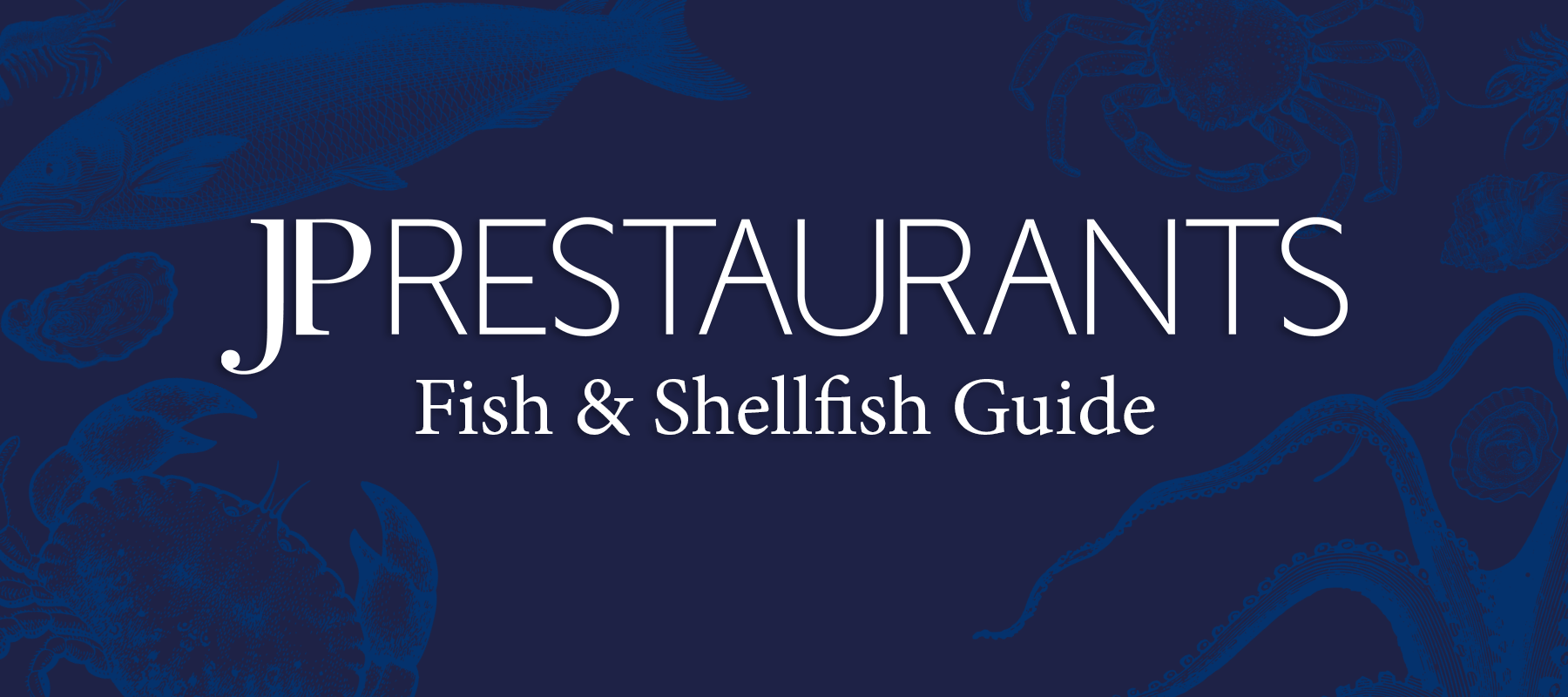
We’ve compiled an A-Z of the fish and shellfish varieties that you’ll find at restaurants in Jersey.
Select a species from the list below to see where it’s most likely to be sourced from.
A-Z of Jersey Fish & Shellfish
•
| First in the alphabetical list. We call it “bass” in Jersey, not the Americanized “sea bass”. One of the best and most plentiful local fish available in local markets, bass is caught by around 10 local day boats. These boats landed around 7200 kg in 2020, both to Jersey and France (according to the latest available figures) which represents around 18,000 portions of fish.
Given that JPRestaurants alone sold over 4,500 bass dishes that year, you can see why farmed or wild-imported bass is predominant on local restaurant menus. We always mark our bass as “wild” when local or day boat UK fish is on the menu, and our team will always be open and transparent when we serve imported or farmed fish. We tend to serve the wild bass pan-fried with simpler sauces to let the taste shine through. There is an easy way to tell if the fish you are eating in a local restaurant is farmed: wild bass must be over 42 cm long, so any whole fish or whole fish filet you see on your plate will be farmed. |
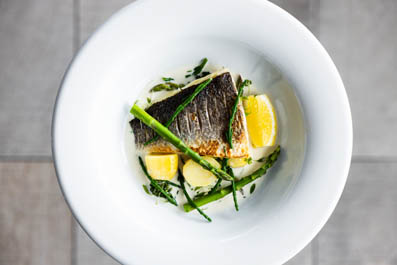
| Wild Bass with samphire and asparagus – Oyster Box |
•
| Plentiful at certain times of the year and targeted by local fishermen, black bream has a darker and more red-tinged flesh than gilt-head bream.
It is cheaper than better-tasting bass, turbot, brill, cod and gilt-head, but large catches are mainly are sold to France. It only occasionally appears on Jersey restaurant menus. |
•
| Superior to the black bream, gilt-head or Royal bream is predominantly a Mediterranean fish. Almost all of the bream you see on local Jersey menus will be farmed.
Recently, there have been small catches of large gilt-head bream by local fishermen. Most are sold directly to retail customers, but some has occasionally ended up on our Fish of the Day menus. As with bass, if you see a whole fish or whole fish filet on your plate, it’s more than likely to be farmed. |
•
| One of the five “kings” of white fish swimming in our waters (the others are turbot, bass, monkfish and dover sole), brill is similar to, but better value, than turbot. It’s one of our favourites and at its best in late summer.
Very little local brill is sold to restaurants, usually ending up on a retail fish counter. This is because only one trawler lands brill locally for direct sale to retail customers. The brill we serve comes predominantly from the southwest English Channel although plenty is caught in Guernsey’s deeper waters. |
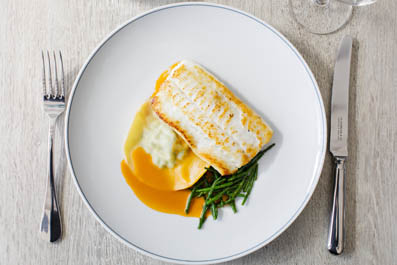
| Brill, lobster ravioli, shellfish sauce – Oyster Box |
•
| With Jersey’s huge tidal ranges, low spring tides offer the opportunity to engage in traditional low-water fishing for clams, including praires and carpet clams.
Cockles are available on most tides, higher up the beach. Only praires are landed commercially (generally by dredging) but only very rarely, and they usually don’t make it onto restaurant tables. Cockles and clams collected on the beach don’t meet current food safety laws for restaurants, as they are not treated. Our live clams come from France. |

| Linguine vongole – Jersey Crab Shack |
•
| The king of fish on the UK mainland, cod are only very rarely caught locally, usually by anglers. They prefer the cold waters of the North Atlantic.
Quality can vary from very good fresh and fresh-frozen large meaty white filets, to grey and flabby cheaper fish that have been stored in a fishing trawler’s hold for several weeks before sale. You get what you pay for! Jersey has a connection to cod: in the 16th to 19th centuries, a Jersey fishing fleet caught cod off Canada and salted it, before returning to sell to markets in the Caribbean and around Europe. So there’s a local link, but the cod on your plate is not local. Contrary to popular belief, frozen cod is often better-tasting and of superior quality to fresh, so we are happy to source high-quality frozen cod for our restaurants. |

| Spiced cod, carrot and coriander salad – Banjo |
•
| Our favourite local crab, chancre crab is delicious in a linguine, picked whole, or in tacos or salad. We have over 10 crab dishes on our menus.
Most crab we serve is local, but at certain times of the year supplies run out and we top up with fresh-picked crab from Devon. Local crab catches have dropped significantly over the last five years, but that is to do with the number of crabs around our shores, not the lack of fishermen targeting them with their pots. We have more than enough local crab to supply local restaurants and food retailers, but for supply chain reasons live crab is exported and most local supermarkets don’t stock Jersey crab, so a significant quantity of crab is imported into Jersey. |

| Spider crab, chancre crab and oysters – Jersey Crab Shack |
•
| Equally tasty as chancre crab (some say more!), spider crab is a little more fiddly to pick. It’s targeted less by fishermen because of its lower value, but with a shortage of chancre it’s becoming more available.
The local catches are generally caught in pots (75%) with the remainder in nets. |
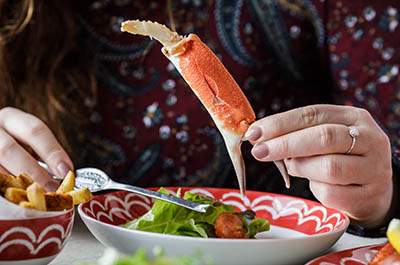
| Whole spider crab – Jersey Crab Shack |
•
| Crayfish, or langouste in French, were caught regularly in lobster pots until the 1960s. Catches then declined and the last recorded year only 4 kg were landed.
A prized catch, even more expensive than lobster, it has a firmer white flesh and was often the star of restaurant banquets in the 1950s. |
•
| Another of the five ”king” local white fish, dover sole, like brill, turbot, and monkfish is a bottom dweller. This means it’s usually caught by trawlers, but occasionally it moves inshore and is caught in static nets.
Like the other four “king” fish, local dover sole are rarely available on restaurant menus. They command a high price in the UK and France: it’s a premium fish, with a higher end fish price like turbot. |
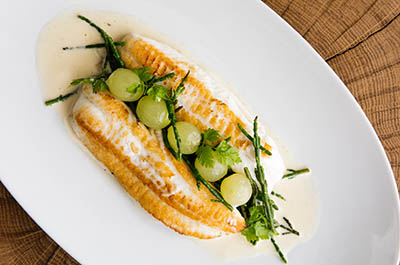
| Sole Véronique – Oyster Box |
•
| Some say a poorer and less flaky (but cheaper) relation of the cod, but it’s one of our favourites for fish and chips.
Not available in local waters, all haddock sold locally comes from the UK. The better quality fish is often fresh-frozen. |
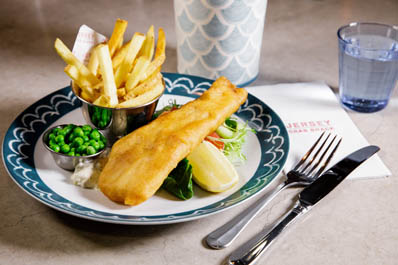
| |Fish & chips – Jersey Crab Shack |
•
| A cheaper meaty fish, popular in Spain, hake doesn’t live around Jersey waters. It’s imported from the UK, where it’s caught in deep Atlantic waters.
Hake is a firm fish that can take a rich sauce, but don’t be persuaded by anyone inferring it’s local. |
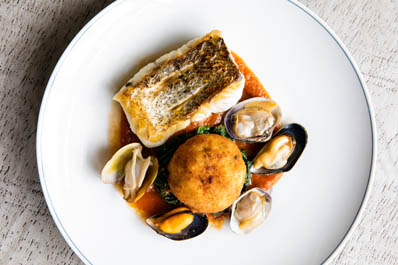
| Hake, chorizo arancini, clams and mussels – Oyster Box |
•
| A large fish with a firm texture and large flakes, halibut can grow to more than two metres. We have it occasionally on our menus.
It doesn’t live in local waters, but rather cold waters of the far north Atlantic. |
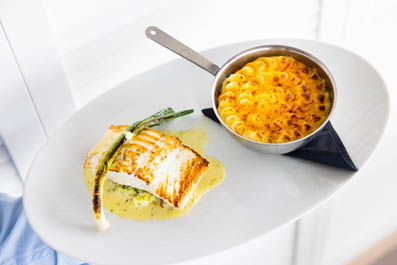
| Halibut, fish pie and baby leeks – Banjo |
•
| Very popular in France, where it is called “St Pierre” because of a black spot and a symbol of St Peter’s thumbprint, John Dory is not a common fish in local fishmongers. We put it on our menus when available.
Catches have increased from around 40 kgs to 400 kgs in last few years but most is landed in France with a few static net caught John Dory occaisionally sold direct by smaller fishing boats to independent restaurants or the general public from fish stalls. If you see John Dory on a Jersey restaurant menu, there is a good chance imported from the UK, where it is caught in the English Channel. |
•
| Langoustine, sometimes called Dublin Bay Prawns or Norway Lobster, are a firm favourite on any plateau royale fruits de mer in France. With a sweeter flesh than lobster, they are best poached cold with mayonnaise.
Sourced almost exclusively in Scottish waters as none are caught around Jersey, they are very expensive and only occasionally appear on our menus. |
•
| A popular and cheaper alternative to dover sole, lemon sole is delicious when it’s sourced well and cooked just right. The flesh is a little less “meaty” than dover sole, but can be equally tasty.
All lemon sole in Jersey comes from the UK, as it is rarely caught locally. |
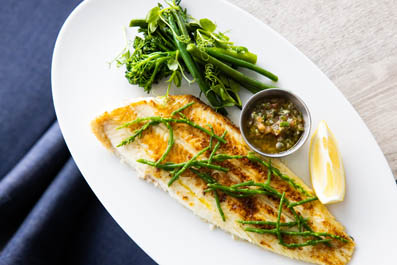
| Grilled lemon sole and spring greens – Oyster Box |
•
| The most valuable shellfish caught locally, and the priciest of local seafood.
Every lobster you eat in Jersey will be local, as unlike in the UK and Europe, Canadian and US lobster can’t be imported to Jersey. Despite its high local price tag (which is set by the French markets, who import most of the local catch), it’s cheaper on menus in Jersey than it is across the water in France. |
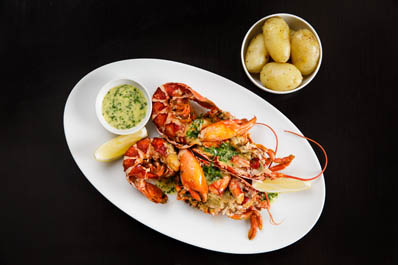
| Grilled lobster and Jersey Royals – Banjo |
•
| Probably the most abundant fish in our local waters from spring to autumn, mackerel is not often targeted by the local commercial fleet but because of its low value and inability to keep like other fish, large single catches are presumably landed predominantly in France and UK. Last recorded year showed catches of 5000 kg, which represents around 10,000 fish.
Nice catches do appear occaisonally in local fishmongers but for the same reasons as other fish don’t often make it to restaurant menus. You will often see smoked mackerel (filet or paté) on menus but this is most likely imported from U.K. smokeries. The local inshore mackerel are also sometimes a little smaller than most served in Jersey restaurants, which come from Brixham market like much of our other imported fish. Fresh and cooked carefully, mackerel is as good as any of the local five “kings”, even if it’s less-loved due to its oily stronger flavour and is therefore a slower seller on restaurant menus. |
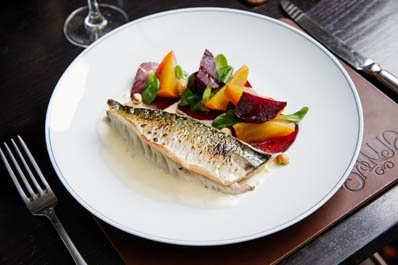
| Grilled mackerel, heritage beetroot salad – Banjo |
•
| Available in small numbers in Jersey waters, but being bottom trawled, virtually all monkfish on Jersey restaurant menus will be imported from the UK. Recent landings have been around 500 kgs per annum with most probably to France.
A fish that can take some spice and the star of our monkfish curry and monkfish scampi, both top sellers at Oyster Box. |
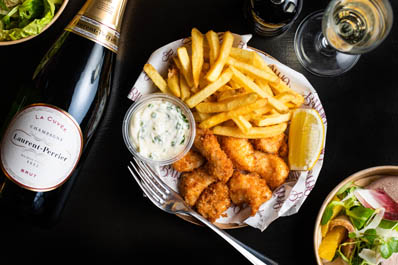
| Monkfish scampi – Banjo |
•
| Most mussels in Jersey are imported, as the local mussels are only sold in April and May. In fact, in the 2022 season, no local mussels are available at all.
We tend to have mussels on the menu until the end of May as the quality drops after then. When we can’t source them locally, they come from Scotland. |
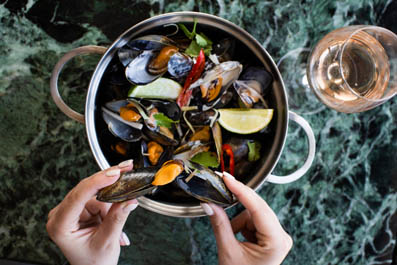
| Coconut mussels, chilli, lime, coriander – Jersey Crab Shack |
•
| Once common in Jersey waters, octopus died out in the big freeze of 1963. It’s making a comeback, but not caught commercially.
Most octopus on local menus is imported from the Atlantic coast of the Iberian peninsula. We’ve recently added an octopus dish to the Oyster Box menu. |

| Grilled octopus, hummus, dukkah, Moroccan chermoula, coriander – Oyster Box |
•
| The ormer (also called abalone in other parts of the world) can only be harvested by hand during the winter ormering season, when fishing must only take place on the first day of each new or full moon and the three following days.
A good spring tide is necessary for a large catch. You may see them in local fishmongers occasionally, but they rarely end up on restaurant menus. |
•
| Stars of the shellfish menu, we don’t need to import oysters from anywhere because of the abundance of sustainable, locally-farmed Jersey oysters.
Our native oysters may have been over-fished in the 19th century and are no longer a viable commercial option being rare in our waters, but Jersey “pacific” oysters from the Jersey Oyster Company are some of the finest in the world. We sell 75,000 a year to our customers who can’t get enough, and Jersey exports millions around the world each year. |

| Jersey Rock oysters, red chilli, pickled ginger, lime juice and coriander – Oyster Box |
•
| At one time, Jersey plaice was ubiquitous on Jersey restaurant menus and still makes a show from time to time.
Plaice is available locally and there is a small local commercial catch as they come further inshore than turbot and brill. But the Jersey plaice on your menu probably hasn’t come from Jersey. Plaice can be good, but it’s a delicate fish that easily spoils and can be less tasty when very fresh or too old, so it doesn’t appear on our menus very often. |

| Plaice, lobster ravioli, samphire, shellfish sauce – Banjo |
•
| You’d be hard-pressed to find a Jersey restaurant or café that doesn’t serve a dish containing prawns . But you can be confident none of them are caught anywhere near Jersey – none were landed in 2019 and a few kilos in 2020. In fact the “prawns” listed on official Jersey catch records are called shrimps by locals.
They are much smaller than the prawns you see on local menus but delicious. The French prize them where they are called crevettes roses or “bouquets” but they are rare and the large ones which can be caught from August in Brittany are more expensive than lobster. At low Spring tides you can be lucky to catch them “shrimping” around rocky outcrops but they don’t make it onto local menus. Most prawns sold in Jersey and on island restaurant menus are farmed in Asia or from cold-water fisheries in the North Atlantic and they are generally imported frozen. Some large tiger prawns are fresh. At JPRestaurants, we know how unsustainably-sourced some imported Asian prawns are, so we go to great lengths to ensure we buy high quality imported prawns from sustainable farms or cold waterprawns from sustainable fisheries in the North Atlantic. Names can be confusing. Prawns in Scotland are what we call langoustine. The Americans call Prawns, Shrimp. Shrimps to us are smaller prawns and indeed the only other native shrimps around Jersey are grey shrimps, which you may see as potted-shrimp on a menu but will probably have come from Morecambe Bay in the U.K. The French call them crevette grises and they can be caught law water fishing on sandy beaches on the East Coast of Jersey. |
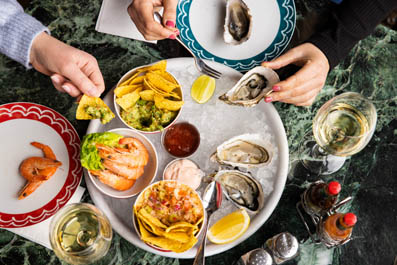
| Grouville Plate with crevettes ( prawns) – Jersey Crab Shack |
•
| Razorfish, or razor clams as they are know in the UK, are caught at low tide with a metal hook or by pouring salt on their sandy burrows.
They are traditionally caught low-water fishing on spring tides in Jersey, and are eaten fried in butter, but they don’t make it to many local restaurant menus. An acquired taste, they pop up quite often in restaurant dishes elsewhere in the world. |
•
| A star of many a Michelin* restaurant in France and with a stronger taste than most other Jersey fish, red mullet is available locally in small numbers, where it is caught inshore in static nets. Red mullet is also imported from the south of England.
We serve local and imported Red Mullet at Oyster Box and Banjo when it’s available. |
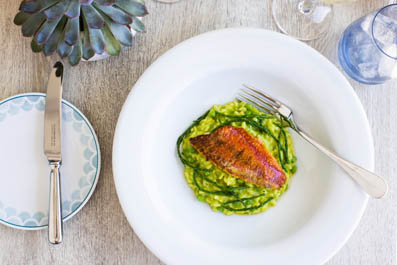
| Red mullet, pea and crab risotto – Oyster Box |
•
| Salmon on local menus is never local and always farmed, generally in Scotland and Norway.
Some salmon farms have a terrible impact on the environment. For this reason and despite its popularity, we have reduced the number of salmon dishes on our menus. We now sell only smoked salmon, that we buy from a single smoker who uses sustainably-farmed fish. |
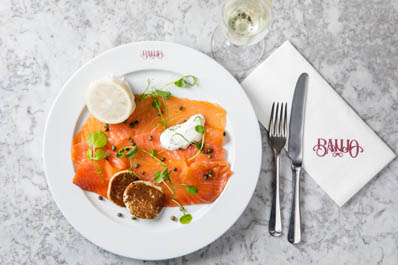
| Smoked salmon, capers, blinis – Banjo |
•
| An occasional visitor to our shores and menus, if you do see a sardine in Jersey, it has probably come from Cornwall.
Cornwall’s large pilchard fishery has had a re-brand; now calling them Cornish Sardines. |
•
| Jersey has fantastic local scallops that are both hand-dived and caught by trawlers dredging. We buy hand-dived scallops.
Very occasionally, and usually in the winter in bad weather when the local divers can’t go to sea, we buy local dredged scallops. |

| Saffron & samphire scallops – Banjo |
•
| A smaller relation of the scallop you see on many restaurant menus in Jersey, the queen scallop is a delicious shellfish. It’s caught occasionally around Jersey, but not in sufficient numbers to make it on to our menu.
Known as Queenies in the Ile of Man, petoncles in Brittany and vanneaux in Normandy, we’d sell them if we could get more. |
•
| Skate is one of the most abundant local fishes. Our local fishery isn’t rated but the species of ray we use is from the English Channel is rated, like bass, by the Marine Conservation Society as OK.
It’s often a by-catch of the local spider crab fishing nets, and we serve it when its available. Skate is a traditional food name covering various rays (undulate, thornback and spotted but not skate, the latter is threatend and to be avoided) that appear on Jersey menus. The fish needs careful handling and preparation to ensure it does not smell of ammonia when it arrives at the table. |
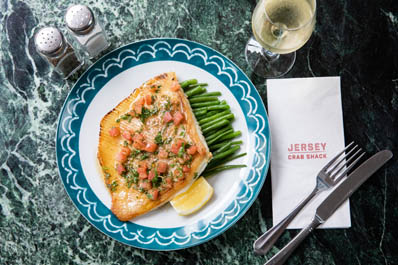
| Skate, green beans, sauce vierge – Jersey Crab Shack |
•
| Jersey waters are full of squid, especially in winter months. Have you seen those black patches of ink on local piers?
Around 400 kg has been caught annually in recent years by local fishermen, but little is available in local wholesale markets, so virtually all the squid on local menus is imported. |
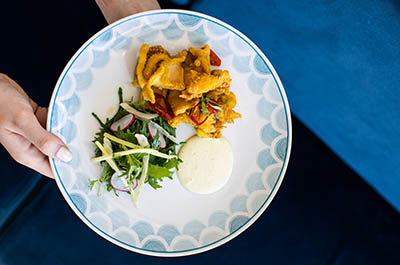
| Fritto misto of squid – Oyster Box |
•
| Bluefin tuna has made a comeback to the Bay of St Malo, but law prohibits fishing for tuna in local waters.
All tuna on local menus is imported. We use pole and line caught yellowfin tuna, which is on the list of least concern. |
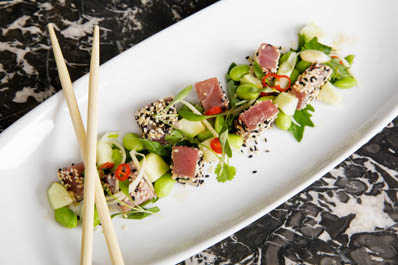
| Seared tuna salad – Oyster Box |
•
| The most premium fish in local waters, but like brill and dover sole, rarely available locally for restaurants to buy.
Some local farmed turbot is available – we choose not to sell it, so any wild turbot on our, and other restaurant, menus in Jersey will come from the English Channel (unless we are lucky enough to source any locally.) |
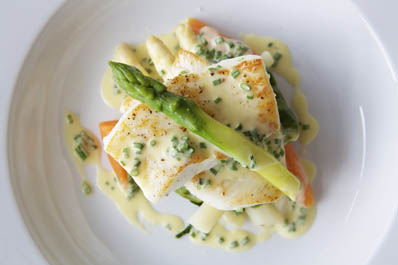
| Turbot, white and green asparagus, chantenay carrots, chive butter sauce – Oyster Box |
•
| There is a sizeable local fishery for whelks, with most exported to Asia. Despite not being very popular when we do have them on our menu, they are always local. |
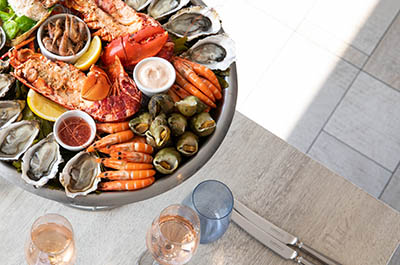
| Fruits de mer Royal (with whelks) – Oyster Box |
•
Winkles are found around Jersey’s shoreline on rocks at low tide. No traditional French fruits de mer would be served without them, together with a pin to take the windy flesh out of the small shell before dipping it in mayonnaise.
We’ve served them in the past on our shellfish platters, but like whelks, they aren’t very popular in Jersey.
•
There are other fish available in Jersey waters that are caught by local fishermen.
As with the more popular varieties listed above, many are landed in France or the UK rather than locally, or used for crab and lobster pot bait.
These include small catches of less premium fish and shellfish such as whiting, grey mullet, red gurnard, dogfish, sand sole, pollack, cuttlefish and velvet crabs which whilst popular in other European markets, don’t sell well in Jersey and therefore aren’t often targeted for sale on local food markets.




